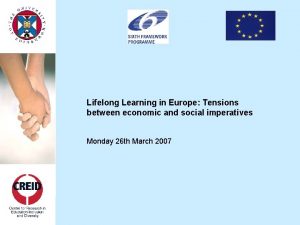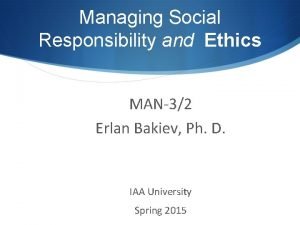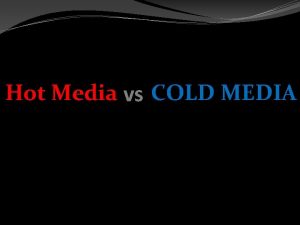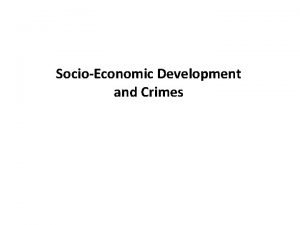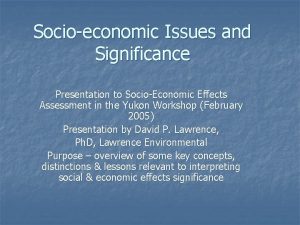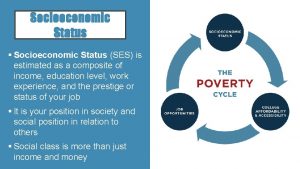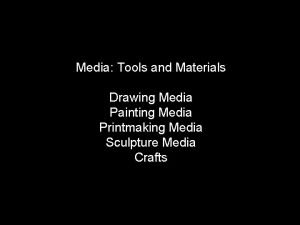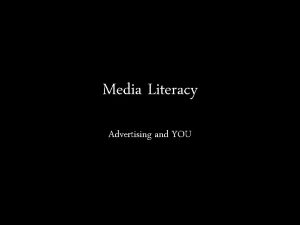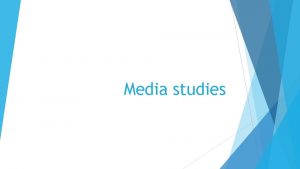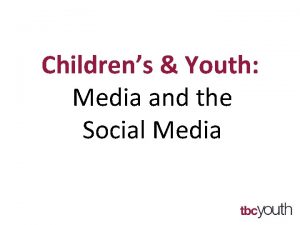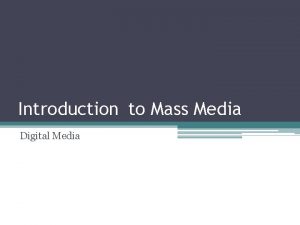Socioeconomic class and the media Socioeconomic class The




























- Slides: 28

Socioeconomic class and the media

Socioeconomic class • The United States has been called a “classless society” – What does that mean? – Is it true? • What is class, anyway?

Socioeconomic class • CLASS. Most sociologists use the term to refer to socioeconomic differences between groups of individuals which create differences in their life chances and power. • (http: //ryoung 001. homestead. com/Sociology. html)

Depictions of class in US media • “The belief that the United States is a classless society or, alternatively, that most Americans are “middle class” persists. . . despite pervasive socioeconomic stratification” • (Bullock, Wyche and Williams, 2001)

Media facilitate “classless society” myth by: • Presenting the interests of the well-off (e. g. , stock, financial portfolios, and leisure time) as general concerns • Downplaying the structural economic concerns (e. g. , job security, income) of the working class and poor, and • Emphasizing shared interclass concerns (e. g. , safety, crime)



Example • Many media stories talk about the economy overall, citing “recovery” etc. but do not look at the differential class-based effect of various policies and events

• “By dedicating little broadcast time or print space to stories that openly discuss class privilege, class-based power differences, and inequalities, the poor are either rendered invisible or portrayed in terms of characterological deficiencies and moral failings (e. g. , substance abuse, crime, sexual, availability, violence). ”

Prime Time programming • Early television included a number of working-class leads – Ralph Cramden – Marty • More recent examples – All in the Family – Roseanne

• However, the tone of Prime Time is heavily white-collar/professional or upper class • The main exceptions are law enforcement personnel in “cop shows, ” ‘reality’ shows and daytime talk shows – Often connect poor and working class with negative depictions, low culture

Depictions of drug crimes • “Although the ‘typical’ drug consumer and dealer is an employed, high-school-educated European American man, the majority of arrests depicted on reality-based crime programs involve African American and Latino men in densely populated, urban areas (Anderson, 1994). ”

Tabloid news shows • Tabloid news shows tended to “focus on stories involving upper-class criminals, particularly celebrities, whereas “highbrow” news programs were more likely to focus on stories involving working-class, unemployed criminals. ” • Also tend to show “rags to riches” stories or the “hollowness of wealth”

• Limited number of stories on poverty on national newscasts. – 11 per network per year 1981 to 1986

Two categories of stories (Entman, 1995) • 239 stories – 39% depicted poverty as a source of threat (e. g. , crime, drugs, and gangs) – 61% portrayed poverty in terms of suffering (e. g. racial discrimination, poor health, and inadequate medical care)

Two frames: (Iyengar, 1990) • Episodic frame – Personal circumstances of a poor individual or family – More common • Thematic frame – Abstract, impersonal approach that looks at general poverty trends and public assistance

Framing effects • Those exposed to episodic frames in an experiment were more likely to blame the poor for their own poverty and to perceive them as responsible for improving their socioeconomic status. Those exposed to thematic frames tended to make structural attributions for poverty and to regard the government as responsible for social change.

Framing effects • Those exposed to episodic frames in an experiment were more likely to blame the poor for their own poverty and to perceive them as responsible for improving their socioeconomic status. Those exposed to thematic frames tended to make structural attributions for poverty and to regard the government as responsible for social change.

• “Welfare recipients are among the. . . the most hated and stereotyped groups in contemporary society” • Only one among 17 stereotyped groups (feminists, housewives, retarded people, Blacks, migrant workers, etc. ) that respondents both disliked and disrespected. – Lacking both competence and warmth • However, most common group of welfare recipients is poor children • Media representations concentrate on their mothers

Content analysis of Newsweek 1993 -1995 • De Goede (1996) found that “the language used in the articles reinforced strong ingroup-outgroup class-based distinctions, simultaneously extolling the moral superiority of the middle class while degrading the values and behaviors of the poor. ” – Single African American mothers and teenage mothers often the focus of these negative articles

Depictions of welfare mothers • “immoral and neglectful, responsible for their own poverty as well as the breakdown of the nuclear family” – “the poster mother for welfare reform spends her days painting her nails, smoking cigarettes, and feeding Pepsi to her baby”

Teenage mothers • Content analysis of over 700 newspaper and magazine stories • Two types of stories – “Wrong girl” stories emphasized flawed psychology of teenage mothers – “Wrong family” stories focused on violation of traditional two-parent ideal

Soap operas • “On soap operas, single mothers are typically portrayed as White, upper-middle-class professionals, with nurturing male friends and an abundance of reliable child care providers (Larson, 1996). ” – “Teenage girls who were heavy viewers of soap operas were more likely than lighter viewers to underestimate the relationship between single motherhood and poverty and to overestimate the percentage of single mothers in high-paying jobs. ”

Connection to race • Content analyses show a great overrepresentation of African Americans in depictions of the poor • Gilens (1996) content analysis of three major news magazines found African Americans were represented in 62% of stories about poverty though they comprised 29% of poor (no more info available) • Asian Americans, stereotyped as hard working and conscientious, rarely show up in stories about the poor • European Americans greatly overestimate the percentage of African Americans who are poor

Stereotypes in media and popular culture • African American men—members of “threatening and violent underclass” • African American women—welfare queens or as “ignorant, promiscuous women caught in a selfperpetuating ‘cycle of dependency’” • Emphasis on African Americans tends to render white poor ‘invisible’ in popular culture

Post welfare reform • April-July 1999 newspapers • 412 articles • 24% contained at least some overt discussion of race/ethnicity • African American articles: – 8 focused on chronic poverty and single motherhood – 5 focused on fraud – 6 highlighted the lives of African Americans who had triumphed over poverty

Welfare reform • 60% of articles took balanced/neutral tone • 32% positive (supported services and programs for the poor) • 8% negative (fraud, drug addiction, etc. )

Welfare recipients • 60% portrayed poor as deserving of support (hard-working families with children in need) • 17% portrayed poor negatively (drug users, neglectful parents) • 14% neutral • 8% mixed
 Socioeconomic model
Socioeconomic model Socioeconomic examples
Socioeconomic examples Status fridge
Status fridge A personality measure of a person's convictions is
A personality measure of a person's convictions is Definition of people media
Definition of people media Hot cold media
Hot cold media Hot media and cold media
Hot media and cold media Advantages and disadvantages of wired and wireless networks
Advantages and disadvantages of wired and wireless networks Hot cold media
Hot cold media Hình ảnh bộ gõ cơ thể búng tay
Hình ảnh bộ gõ cơ thể búng tay Bổ thể
Bổ thể Tỉ lệ cơ thể trẻ em
Tỉ lệ cơ thể trẻ em Gấu đi như thế nào
Gấu đi như thế nào Tư thế worm breton
Tư thế worm breton Hát lên người ơi alleluia
Hát lên người ơi alleluia Các môn thể thao bắt đầu bằng từ đua
Các môn thể thao bắt đầu bằng từ đua Thế nào là hệ số cao nhất
Thế nào là hệ số cao nhất Các châu lục và đại dương trên thế giới
Các châu lục và đại dương trên thế giới Công thức tính thế năng
Công thức tính thế năng Trời xanh đây là của chúng ta thể thơ
Trời xanh đây là của chúng ta thể thơ Cách giải mật thư tọa độ
Cách giải mật thư tọa độ Phép trừ bù
Phép trừ bù Phản ứng thế ankan
Phản ứng thế ankan Các châu lục và đại dương trên thế giới
Các châu lục và đại dương trên thế giới Thơ thất ngôn tứ tuyệt đường luật
Thơ thất ngôn tứ tuyệt đường luật Quá trình desamine hóa có thể tạo ra
Quá trình desamine hóa có thể tạo ra Một số thể thơ truyền thống
Một số thể thơ truyền thống Cái miệng nó xinh thế chỉ nói điều hay thôi
Cái miệng nó xinh thế chỉ nói điều hay thôi
